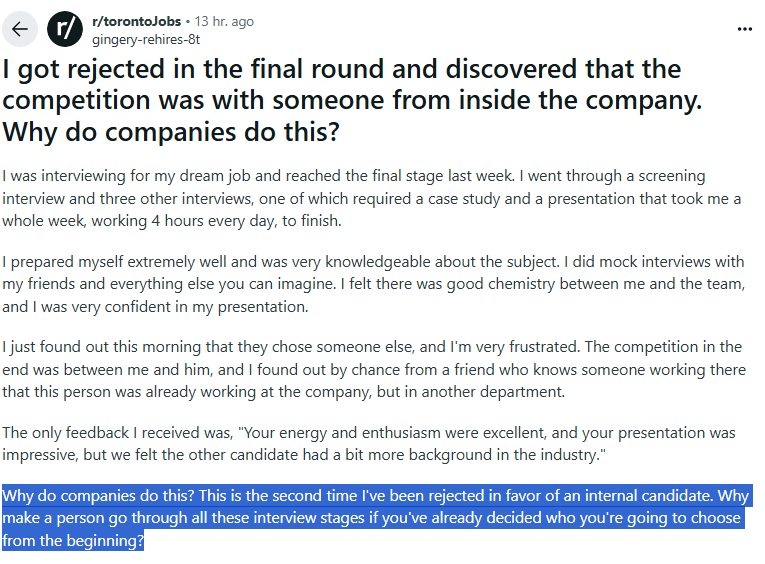Why Do Companies Do This?
When Hiring Policies Encourage Malicious Compliance
TODAY’S NEWSLETTER is inspired by the above Reddit post where the OP describes their frustrating experience interviewing for a job that they later discover was going to an internal candidate all along. The answer goes to the heart of a very Deming-aligned observation about meets specifications thinking, which extends to applications outside of manufacturing.
Recap: Meets Specifications Thinking
Long-time readers will recall this diagram from my Oct. 25/21 post on the Taguchi Loss Function. It describes the typical way we’ve been conditioned to think about on-target/off-target success as a step function: You’re either “meeting the spec” set out for you, with some “wiggle room” or you’re not — losses are accordingly zero or non-zero:
Some examples:
You need to be “this” tall to get on the ride.
The speed limit on sections of the 400N around Parry Sound are 110 km/h, 100 km/h otherwise.
To be accepted into this university, you must have an average of 85% or a 3.0 GPA.
You can probably think of more. Each nominal value (tau in the diagram) either has zero or non-zero tolerance for ∆x and ∆y — in other words the plus or minus effect that is still considered a “win”. And herein lies the difference: the wiggle room.
Continuum Thinking
Remember this good boy? Is he complying with the policy on the sign?
It depends on how you define “point”: technically, most of his body is behind the signpost, but he still has his front paws, chest, and head forward, sniffing the salty sea air. You probably know this effect by another term: respecting the spirit of the law, versus the letter. You might also know this by the more subversive term: malicious compliance.
Dr. Taguchi’s brilliance, back in 1960, was realizing that while we typically try to frame the world in a meets/does not meet context, in reality it’s more of a continuum with shades of losses not just to us in the business, but to society that come from what we “settle” with achieving:
The struggle we have is coping with how to get ourselves over the target with minimal losses on either side of the nominal value. Under- or over-shoot and there are not only losses to you, but your colleagues, your peers, your leadership, the organization, their customers, and out into society itself.
What Does This Have to Do With OP’s Complaint?
You can probably guess where this is all headed: a difference in what it means to satisfy the requirements of a job posting when framed in a “meets spec” view over the reality of a “continuum”.
The managers did, as they suspected, have an internal candidate already selected, but they have to follow an internal policy for posting the job, recruiting candidates, and wasting their time with a fake series of interviews. The managers are “meeting the spec” of the policy, while accruing the “losses” from their actions.
This can be viewed one of two ways:
The internal candidate is the best person they’d like to hire into the role because they’ve been invested in and understand the company culture and processes, enabling them to become effective more rapidly than an outsider. The managers are just hamstrung by a bad policy based on the notion that “performative adversarial competition” yields better results.
The internal candidate may actually not be better qualified than an outsider, but is a friend or “team-player” and so the actions of management satisfy the policy at the cost of bringing new viewpoints, insights, and skills into the organization.
Either way, the problem is with the policy and how it is followed like our Good Doggo above with his snout to the salty sea breezes. It could be reasoned that the losses for the first option are less than those for the first, but if the internal candidate doesn’t help innovate new ways of doing things, ie. they just perpetuate the dominant culture that created the policy in the first place, the losses could be the same or more.
Rx? Cure the policy.
The problem to be addressed is the adherence to policies that don’t fulfill the aim of hiring. This is why I often recommend to new management coachees to map their hiring workflows to see where there are blindspots that encourage workarounds. Ask managers what works in the hiring practices, why they would prefer an internal candidate over having to go through the process of posting a role, recruiting, screening, and interviewing. What could be done to optimize meeting the aim of the organization while respecting local and federal laws?
What do you think?
Have you observed this practice in your organization or experience? Of course you have. What was the context? How was it tolerated? Is it an acknowledged way of “working the system” to get what you want? What was the fallout? What could have been done differently?
Let me know your thoughts below!








I have also seen the other side of the equation: if the company DOESN'T hire the internal candidate there's chance the internal candidate quits in anger, continues fishing around for the role they got rejected for in another company or 'quiet quits'.
It's that same 'trap' when you give a company 30 days notice you're quitting. They suddenly start treating you in bizarre, often evil, ways.
The rationale for the policy that I've seen is two-fold:
- there may be other internal candidates that are qualified or interested, and the job posting board is used to notify them - and if they find out there was an opportunity but they weren't notified they will raise a stink or quit; and
- the job board is not sophisticated enough to differentiate internal and external posted roles
The deeper system is that there is a hierarchy and competition for roles - which needs to be examined and changed to create better engagement and economic participation (eg profit sharing).